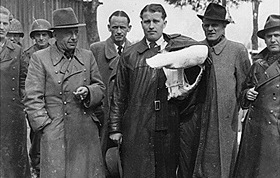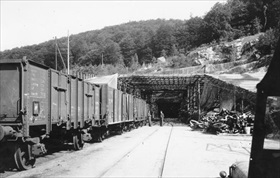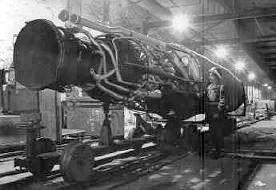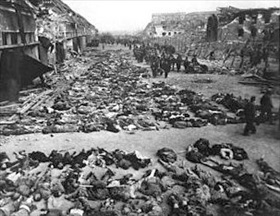REDS IMPOSE PEACE, U.S. CAPTURES ROCKET SCIENTISTS
SHAEF HQ, Versailles, France · May 2, 1945
On this date in 1945, a rain-sodden but peaceful day in Berlin, the battle for the war-ravaged Reich capital ended when General of the Artillery Helmuth Weidling surrendered his garrison to Soviet Lt. Gen. Vasily Chuikov. The Soviets claimed to have taken 480,000 POWs, captured 1,500 enemy tanks and self-propelled guns, 4,500 aircraft, and 11,000 guns and mortars during the half-month offensive, the fourth largest of the war. An estimated 100,000 civilians perished in the Battle of Berlin; nearly 4,000 were registered suicides (April’s numbers), with countless more going unregistered.
Rape victims, the flipside of the Soviet orgy of looting, numbered between 95,000 and well past 130,000 and feature as one of the most horrific aspects of the Berlin battle. Ten percent of the rape victims committed suicide. One Soviet war reporter recalled the Red Army as “an army of rapists.” An estimated five percent of the children born in Berlin in 1946 were so-called Russenkinder.
Southwest of Berlin, in Southern Bavaria, while peddling his bicycle with a white handkerchief tied to the handlebars, Magnus von Braun, Wernher von Braun’s brother, encountered a shocked American private in the U.S. Seventh Army. Wernher von Braun and his team of V‑2 Peenemuende rocket engineers had just learned of Hitler’s death and sent the English-speaking younger von Braun to scout for someone to surrender to. Within days roughly 50 members of von Braun’s team were in U.S. custody.
Three weeks earlier American troops had overrun the underground V‑2 production facilities and the adjacent but nearly empty Mittelbau-Dora forced labor camp. Mittelwerk, as these production facilities were called, had been set up in Central (now Eastern) Germany for V‑2 production after the August 1943 bombing of the V‑2 Army Research Center at Peenemuende on the German Baltic coast. At Mittelwerk prisoners were put to work building V‑2 rockets under the direction of von Braun senior. GIs secured nearly 350 railway cars to cart away as many V‑2 rockets, parts, machine tools, and engineering drawings as possible before the area passed into Soviet hands under the agreement establishing Allied zones of occupation. Under tight security, the rockets—and von Braun and his rocketeers—eventually wound up, via Antwerp, Belgium, and New Orleans, at the White Sands Proving Ground in the New Mexico desert, the birthplace of U.S. rocket technology and space science.
Wernher von Braun, Mittelwerk V-2 Production Plant, and Slave Labor
 |  |
Left: German rocketeers shortly after being taken prisoner by units of the 44th Infantry Division, U.S. Seventh Army, May 3, 1945. Wernher von Braun, age 33, stands in the center of the photo, suffering from an arm broken in a car accident. His brother, Magnus von Braun, is seen at left edge of photo. Operation Paperclip, a decades-long covert project, brought many of von Braun’s team members (and their families) to the United States, where the scientists worked under contract with the U.S. Army Ordnance Corps.
![]()
Right: The Mittelwerk V‑1 and V‑2 factories occupied large tunnels underneath Kohnstein Mountain several miles northwest of the town of Nordhausen in what is now Eastern Germany. The factories used slave labor from the Mittelbau-Dora concentration camp, a subcamp of Buchenwald. Von Braun visited the underground production facilities twice between January and May 1944.
 |  |
Left: A GI inspects a V‑2 ballistic missile at the underground Mittelwerk facility. About 250 V‑2 missiles were found in various stages of completion on the Mittelwerk assembly line.
![]()
Right: Rows of dead inmates fill the yard of the Boelcke Barracks at Nordhausen Camp, April 12, 1945, one day after the camp’s liberation. (Nordhausen and Dora were separate camps within the same 40‑plus Konzentrationslager Mittelbau complex.) Used as an overflow camp for sick and dying inmates from January 1945, Nordhausen saw its numbers rise from a few hundred to over 6,000, when up to 100 inmates died every day. Around 1,300 inmates died on the night of April 2, 1945, when British bombs destroyed substantial parts of the barracks during raids that destroyed three-quarters of the town of Nordhausen.
Mittelbau-Dora Concentration Camp and Underground Mittelwerk V‑2 Production Plant (NOTE: Excellent content marred by corny cartoon “presenter”)
![]()

 History buffs, there is good news! The Daily Chronicles of World War II is now available as an ebook for $4.99 on Amazon.com. Containing a year’s worth of dated entries from this website, the ebook brings the story of this tumultuous era to life in a compelling, authoritative, and succinct manner. Featuring inventive navigation aids, the ebook enables readers to instantly move forward or backward by month and date to different dated entries. Simple and elegant! Click
History buffs, there is good news! The Daily Chronicles of World War II is now available as an ebook for $4.99 on Amazon.com. Containing a year’s worth of dated entries from this website, the ebook brings the story of this tumultuous era to life in a compelling, authoritative, and succinct manner. Featuring inventive navigation aids, the ebook enables readers to instantly move forward or backward by month and date to different dated entries. Simple and elegant! Click 











